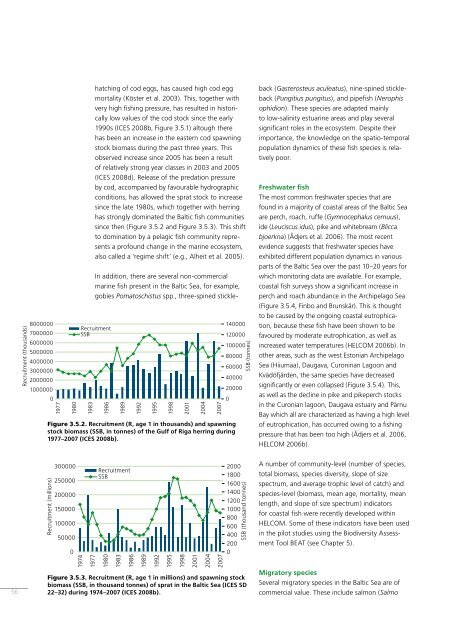BSEP116B Biodiversity in the Baltic Sea - Helcom
BSEP116B Biodiversity in the Baltic Sea - Helcom
BSEP116B Biodiversity in the Baltic Sea - Helcom
You also want an ePaper? Increase the reach of your titles
YUMPU automatically turns print PDFs into web optimized ePapers that Google loves.
Recruitment (thousands)<br />
8000000<br />
7000000<br />
6000000<br />
5000000<br />
4000000<br />
3000000<br />
2000000<br />
1000000<br />
0<br />
1977<br />
1980<br />
hatch<strong>in</strong>g of cod eggs, has caused high cod egg<br />
mortality (Köster et al. 2003). This, toge<strong>the</strong>r with<br />
very high fish<strong>in</strong>g pressure, has resulted <strong>in</strong> historically<br />
low values of <strong>the</strong> cod stock s<strong>in</strong>ce <strong>the</strong> early<br />
1990s (ICES 2008b, Figure 3.5.1) altough <strong>the</strong>re<br />
has been an <strong>in</strong>crease <strong>in</strong> <strong>the</strong> eastern cod spawn<strong>in</strong>g<br />
stock biomass dur<strong>in</strong>g <strong>the</strong> past three years. This<br />
observed <strong>in</strong>crease s<strong>in</strong>ce 2005 has been a result<br />
of relatively strong year classes <strong>in</strong> 2003 and 2005<br />
(ICES 2008d). Release of <strong>the</strong> predation pressure<br />
by cod, accompanied by favourable hydrographic<br />
conditions, has allowed <strong>the</strong> sprat stock to <strong>in</strong>crease<br />
s<strong>in</strong>ce <strong>the</strong> late 1980s, which toge<strong>the</strong>r with herr<strong>in</strong>g<br />
has strongly dom<strong>in</strong>ated <strong>the</strong> <strong>Baltic</strong> fish communities<br />
s<strong>in</strong>ce <strong>the</strong>n (Figure 3.5.2 and Figure 3.5.3). This shift<br />
to dom<strong>in</strong>ation by a pelagic fish community represents<br />
a profound change <strong>in</strong> <strong>the</strong> mar<strong>in</strong>e ecosystem,<br />
also called a ’regime shift’ (e.g., Alheit et al. 2005).<br />
In addition, <strong>the</strong>re are several non-commercial<br />
mar<strong>in</strong>e fish present <strong>in</strong> <strong>the</strong> <strong>Baltic</strong> <strong>Sea</strong>, for example,<br />
gobies Pomatoschistus spp., three-sp<strong>in</strong>ed stickle-<br />
Recruitment<br />
SSB<br />
1983<br />
1986<br />
1989<br />
1992<br />
1995<br />
1998<br />
2001<br />
2004<br />
2007<br />
140000<br />
120000<br />
100000<br />
80000<br />
60000<br />
40000<br />
20000<br />
Figure 3.5.2. Recruitment (R, age 1 <strong>in</strong> thousands) and spawn<strong>in</strong>g<br />
stock biomass (SSB, <strong>in</strong> tonnes) of <strong>the</strong> Gulf of Riga herr<strong>in</strong>g dur<strong>in</strong>g<br />
1977–2007 (ICES 2008b).<br />
0<br />
SSB (tonnes)<br />
back (Gasterosteus aculeatus), n<strong>in</strong>e-sp<strong>in</strong>ed stickleback<br />
(Pungitius pungitus), and pipefish (Nerophis<br />
ophidion). These species are adapted ma<strong>in</strong>ly<br />
to low-sal<strong>in</strong>ity estuar<strong>in</strong>e areas and play several<br />
significant roles <strong>in</strong> <strong>the</strong> ecosystem. Despite <strong>the</strong>ir<br />
importance, <strong>the</strong> knowledge on <strong>the</strong> spatio-temporal<br />
population dynamics of <strong>the</strong>se fish species is relatively<br />
poor.<br />
Freshwater fish<br />
The most common freshwater species that are<br />
found <strong>in</strong> a majority of coastal areas of <strong>the</strong> <strong>Baltic</strong> <strong>Sea</strong><br />
are perch, roach, ruffe (Gymnocephalus cernuus),<br />
ide (Leuciscus idus), pike and whitebream (Blicca<br />
bjoerkna) (Ådjers et al. 2006). The most recent<br />
evidence suggests that freshwater species have<br />
exhibited different population dynamics <strong>in</strong> various<br />
parts of <strong>the</strong> <strong>Baltic</strong> <strong>Sea</strong> over <strong>the</strong> past 10–20 years for<br />
which monitor<strong>in</strong>g data are available. For example,<br />
coastal fish surveys show a significant <strong>in</strong>crease <strong>in</strong><br />
perch and roach abundance <strong>in</strong> <strong>the</strong> Archipelago <strong>Sea</strong><br />
(Figure 3.5.4, F<strong>in</strong>bo and Brunskär). This is thought<br />
to be caused by <strong>the</strong> ongo<strong>in</strong>g coastal eutrophication,<br />
because <strong>the</strong>se fish have been shown to be<br />
favoured by moderate eutrophication, as well as<br />
<strong>in</strong>creased water temperatures (HELCOM 2006b). In<br />
o<strong>the</strong>r areas, such as <strong>the</strong> west Estonian Archipelago<br />
<strong>Sea</strong> (Hiiumaa), Daugava, Curon<strong>in</strong>an Lagoon and<br />
Kvädöfjärden, <strong>the</strong> same species have decreased<br />
significantly or even collapsed (Figure 3.5.4). This,<br />
as well as <strong>the</strong> decl<strong>in</strong>e <strong>in</strong> pike and pikeperch stocks<br />
<strong>in</strong> <strong>the</strong> Curonian lagoon, Daugava estuary and Pärnu<br />
Bay which all are characterized as hav<strong>in</strong>g a high level<br />
of eutrophication, has occurred ow<strong>in</strong>g to a fish<strong>in</strong>g<br />
pressure that has been too high (Ådjers et al. 2006,<br />
HELCOM 2006b).<br />
56<br />
Recruitment (millions)<br />
300000<br />
250000<br />
200000<br />
150000<br />
100000<br />
50000<br />
0<br />
1974<br />
1977<br />
Recruitment<br />
SSB<br />
1980<br />
1983<br />
1986<br />
1989<br />
Figure 3.5.3. Recruitment (R, age 1 <strong>in</strong> millions) and spawn<strong>in</strong>g stock<br />
biomass (SSB, <strong>in</strong> thousand tonnes) of sprat <strong>in</strong> <strong>the</strong> <strong>Baltic</strong> <strong>Sea</strong> (ICES SD<br />
22–32) dur<strong>in</strong>g 1974–2007 (ICES 2008b).<br />
1992<br />
1995<br />
1998<br />
2001<br />
2004<br />
2007<br />
2000<br />
1800<br />
1600<br />
1400<br />
1200<br />
1000<br />
800<br />
600<br />
400<br />
200<br />
0<br />
SSB (thousand tonnes)<br />
A number of community-level (number of species,<br />
total biomass, species diversity, slope of size<br />
spectrum, and average trophic level of catch) and<br />
species-level (biomass, mean age, mortality, mean<br />
length, and slope of size spectrum) <strong>in</strong>dicators<br />
for coastal fish were recently developed with<strong>in</strong><br />
HELCOM. Some of <strong>the</strong>se <strong>in</strong>dicators have been used<br />
<strong>in</strong> <strong>the</strong> pilot studies us<strong>in</strong>g <strong>the</strong> <strong>Biodiversity</strong> Assessment<br />
Tool BEAT (see Chapter 5).<br />
Migratory species<br />
Several migratory species <strong>in</strong> <strong>the</strong> <strong>Baltic</strong> <strong>Sea</strong> are of<br />
commercial value. These <strong>in</strong>clude salmon (Salmo

















